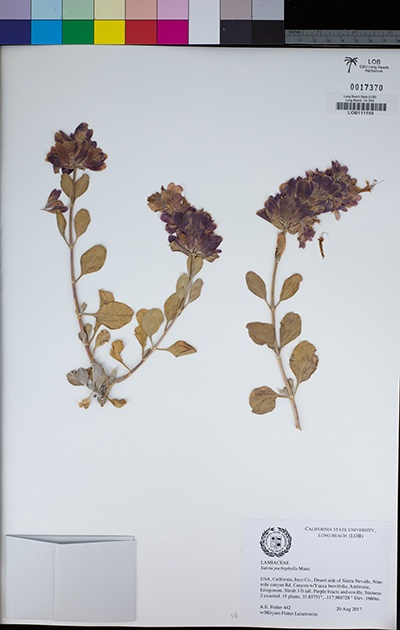NSF Funding to Digitize Herbarium at Cal State Long Beach

LONG BEACH, CALIF. – Dr. Amanda Fisher in the Biological Sciences Department at California State University, Long Beach today announced that she has received NSF funding to digitize the university's plant collection as part of a large California-wide collaboration to understand the effects of climate change on flowering time. The National Science Foundation has awarded $1.8 million for this project, called Capturing California's Flowers. The funds have been distributed among 22 participating herbaria (preserved plant collections) throughout the state.
The project will produce nearly 1 million digital images of plant specimens housed in herbaria throughout California. These plant records go back almost 200 years and include data pertaining to when and where the plant specimen was collected. This project will capture the time and place of each collection, as well as data about the flowering and fruiting condition of each specimen. The results of this project will allow researchers to combine the historical data with current flowering time trends.
All of the images and data will be made available to the public in a new online database.
The California State University, Long Beach Herbarium will receive $28,675 to digitize 11,000 records. The total collection has 18,000 plant specimens that are used in teaching and research. The specimens provide a long-term reference of the plants of Southern California and beyond. The funds will be used to improve herbarium infrastructure and support students who will participate in this effort.
NSF Abstract
Flowering time is an important biological phenomenon, affecting human societies through its effects on agricultural crops, pollinators, pests, and biodiversity. Given the sensitivity of flowering times to climatic conditions, a thorough understanding of how plants respond to changing environments is necessary for predicting the consequences for pollinators, herbivores, parasites, and plant populations. A record of historical flowering times is found within the nation's herbaria. This award establishes a thematic collection network (TCN) dedicated to understanding flowering time shifts in the California flora. California has the most diverse native flora of any state in the U.S., containing more than one-third of all U.S. plant species. The state is a biodiversity hotspot due to the high number of endemic species that are also threatened. The Capturing California's Flowers (CCF) TCN will record flowering times from and create images of over 900,000 herbarium specimens from the oldest records, the most diverse families, and most threatened families in California. Twenty-two institutions spanning the state, including public universities, state agencies, museums, and botanic gardens, will participate in these efforts. This project will generate data that will increase our understanding of flowering time shifts - a critical need for agriculturalists, conservation biologists, plant taxonomists, land managers, and wildlife biologists.
Digitization of each specimen in the CCF TCN will result in a high-resolution image, a databased record of collection metadata, a georeferenced point, and the reproductive status of the specimen. New tools will be developed for the public to search and display phenological data through a Symbiota portal interface. The CCF TCN will develop novel data standards for capturing and sharing trait data from specimens. Building on already successful national and regional programs, the CCF TCN will partner with schools, universities, botanical clubs, and the general public to crowd source phenological measurements through online expeditions, workshops, new college courses, and K-12 educational programs. The CCF TCN will provide a historical record of plants currently being monitored through the National Phenology Network and other regional programs. Finally, this award will expand efforts to train the "next generation" of museum curators, collectors, and researchers. This award is made as part of the National Resource for Digitization of Biological Collections through the Advancing Digitization of Biological Collections program, and all data resulting from this award will be available through the national resource (iDigBio.org).
This award reflects NSF's statutory mission and has been deemed worthy of support through evaluation using the Foundation's intellectual merit and broader impacts review criteria.
Photo credits: Laymon Ball (banner), Amanda Fisher (dried sage)





